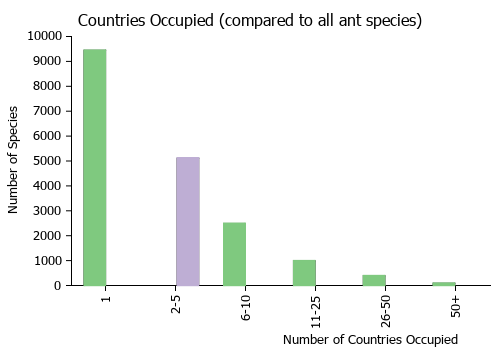Gnamptogenys nana
| Gnamptogenys nana | |
|---|---|

| |
| Scientific classification | |
| Kingdom: | Animalia |
| Phylum: | Arthropoda |
| Class: | Insecta |
| Order: | Hymenoptera |
| Family: | Formicidae |
| Subfamily: | Ectatomminae |
| Tribe: | Ectatommini |
| Genus: | Gnamptogenys |
| Species: | G. nana |
| Binomial name | |
| Gnamptogenys nana Kempf, 1960 | |
| Synonyms | |
| |
Nothing is known about the biology of Gnamptogenys nana. Its nearest relatives, Gnamptogenys horni and Gnamptogenys regularis include beetles as a significant part of their diets, while horni also preys on ants.
Identification
A member of the regularis complex (in the regularis subgroup of the mordax species group). Head subquadrate, mandibles subtriangular with striae at base, clypeal lamella straight, no transverse mesosomal impressions, propodeal declivity with vertical costulae. (Lattke 1995)
Keys including this Species
Distribution
Latitudinal Distribution Pattern
Latitudinal Range: -22.468° to -22.468°.
| North Temperate |
North Subtropical |
Tropical | South Subtropical |
South Temperate |
- Source: AntMaps
Distribution based on Regional Taxon Lists
Neotropical Region: Argentina, Brazil (type locality).
Distribution based on AntMaps
Distribution based on AntWeb specimens
Check data from AntWeb
Countries Occupied
| Number of countries occupied by this species based on AntWiki Regional Taxon Lists. In general, fewer countries occupied indicates a narrower range, while more countries indicates a more widespread species. |

|
Estimated Abundance
| Relative abundance based on number of AntMaps records per species (this species within the purple bar). Fewer records (to the left) indicates a less abundant/encountered species while more records (to the right) indicates more abundant/encountered species. |

|
Biology
Castes
Nomenclature
The following information is derived from Barry Bolton's Online Catalogue of the Ants of the World.
- nana. Gnamptogenys nana Kempf, 1960f: 422, figs. 7-9 (w.) BRAZIL (São Paulo).
- Type-material: holotype worker.
- Type-locality: Brazil: São Paulo, Agudos, 29.viii.1958 (R. Mueller).
- Type-depository: MZSP.
- Status as species: Kempf, 1972a: 113; Kempf, 1978: 35; Brandão, 1991: 345; Bolton, 1995b: 209; Lattke, 1995: 177; Lattke, et al. 2007: 260 (in key); Feitosa, 2015c: 98; Camacho, et al. 2020: 457 (in key); Camacho, Franco, Branstetter, et al. 2022: 11.
- Senior synonym of dina: Kempf, 1978b: 35; Brandão, 1991: 346; Bolton, 1995b: 209; Lattke, 1995: 177.
- Distribution: Argentina, Brazil.
- dina. Parectatomma dina Kusnezov, 1969: 35 (diagnosis in key) (w.) ARGENTINA (Salta).
- Type-material: holotype worker, 5 paratype workers.
- Type-locality: holotype Argentina: Salta, Alemanía, 18.ii.1948 (N. Kusnezov); paratypes with same data.
- Type-depository: IMLT.
- Junior synonym of nana: Kempf, 1978b: 35; Brandão, 1991: 346; Bolton, 1995b: 208; Lattke, 1995: 177.
Description
References
- Albuquerque, E., Prado, L., Andrade-Silva, J., Siqueira, E., Sampaio, K., Alves, D., Brandão, C., Andrade, P., Feitosa, R., Koch, E., Delabie, J., Fernandes, I., Baccaro, F., Souza, J., Almeida, R., Silva, R. 2021. Ants of the State of Pará, Brazil: a historical and comprehensive dataset of a key biodiversity hotspot in the Amazon Basin. Zootaxa 5001, 1–83 (doi:10.11646/zootaxa.5001.1.1).
- Camargo, K.S. de. 2011. Composicao e diversidade de "Poneromorfas" (Hymenoptera, Formicidae) em duas fitofisionomias de cerrado e padroes de distribuicao de "Poneromorfas", Pseudomyrmecinae e Cephalotini (Myrmicinae) para o Brasil. Thesis, Universidade de Brasilia.
- Kempf, W. W. 1960f. Miscellaneous studies on Neotropical ants (Hymenoptera, Formicidae). Studia Entomologica. 3:417-466.
- Kempf, W. W. 1978b. Five new synonyms for the Argentine ant fauna (Hymenoptera, Formicidae). 112. Studia Entomologica. 20:35-38.
- Lattke, J. E. 1995. Revision of the ant genus Gnamptogenys in the New World (Hymenoptera: Formicidae). Journal of Hymenoptera Research. 4:137-193.
- Lattke, J.E., Fernández, F. & Palacio, E.E. 2007. Identification of the species of Gnamptogenys Roger in the Americas (pp. 254-270). In Snelling, R.R., Fisher, B.L. & Ward, P.S. (eds). Advances in ant systematics: homage to E.O. Wilson – 50 years of contributions. Memoirs of the American Entomological Institute 80: 690 pp.
References based on Global Ant Biodiversity Informatics
- Brandao, C.R.F. 1991. Adendos ao catalogo abreviado das formigas da regiao neotropical (Hymenoptera: Formicidae). Rev. Bras. Entomol. 35: 319-412.
- Kempf W. W. 1960. Miscellaneous studies on Neotropical ants (Hymenoptera, Formicidae). Studia Entomologica (n.s.)3: 417-466.
- Kempf W. W. 1961. Nota preliminar sôbre a fauna das formigas de Agudos, S. P. (Hymenoptera: Formicidae). Revista Brasileira de Entomologia 10: 205-208.
- Kempf W. W. 1978. A preliminary zoogeographical analysis of a regional ant fauna in Latin America. 114. Studia Entomologica 20: 43-62.
- Kempf W. W. 1978. Five new synonyms for the Argentine ant fauna (Hymenoptera, Formicidae). 112. Studia Entomologica 20: 35-38.
- Kempf, W.W. 1972. Catalago abreviado das formigas da regiao Neotropical (Hym. Formicidae) Studia Entomologica 15(1-4).
- Lattke J. E. 1995. Revision of the ant genus Gnamptogenys in the New World (Hymenoptera: Formicidae). Journal of Hymenoptera Research 4: 137-193
- Scott-Santos, C.P., F.A. Esteves, C.R.F. Brandao. 2008. Catalogue of "Poneromorph" ant type specimens (Hymenoptera, Formicidae) deposited in the Museu de Zoologia da Universidade de Sao Paulo, Brazil. Papeis Avulsos de Zoologia 48(11):75-88.

